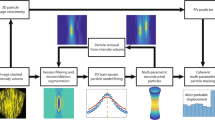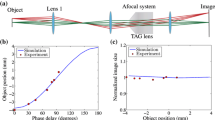Abstract
A three-dimensional micro-particle tracking velocimetry (micro-PTV) scheme is presented using a single camera with deconvolution microscopy. This method devises tracking of the line-of-sight (z) flow vectors by correlating the diffraction pattern ring size variations with the defocusing distances of small particle locations. The working principle is based on optical serial sectioning microscopy, or equivalently deconvolution microscopy, that records images of an infinitesimally small particle, and generates a point-spread function of the three-dimensional diffraction patterns. A new image-processing algorithm has also been developed to digitally identify the center locations and measure the radii of the diffraction rings, which allows simultaneous tracking of all three-vector components. The developed PTV technique uses a 40×, 0.75 NA dry objective lens with 500-nm fluorescent seeding particles of SG=1.05, and successfully measures the fully three-dimensional fields flowing over a spherical obstacle snuggly fitted inside a 100 μm × 100 μm micro-channel. The volumetric measurement resolution of the present system is equivalent to a 5.16 μm × 5.16 μm × 5.16 μm cube, and the overall measurement uncertainty for single-point velocity vector detection is estimated to ±7.58%.






Similar content being viewed by others
Notes
M (overall magnification of microscopy)=40, NA=0.75, λ (emission light wavelength)=515 nm (Ar-ion laser source), t g (cover glass thickness)=0.21 mm, t i (immersion thickness)=0.483 mm, n g (refractive index of cover glass)=1.51, n s (refractive index of specimen medium)=1.33 (water), and n i (refractive index of immersion)=1.0 (air).
A regression of the calculated correlation provides a third-order polynomial approximation of \( {\left[ {\Delta z\, = \,A \cdot r^{3} + B \cdot r^{2} + C \cdot r + D} \right]} \) with fitting coefficients of A=0.0003, B = -0.028, C=1.0747, and D=0.4326. This functional form of the correlation will be useful in computational determination of the ring radii as will be discussed in the later section.
For instances, it can represent a practical situation such as a hydrogen bubble trapped in a PEM fuel cell operation, or an air bubble trapped in a lab-on-a-chip microfluidic device for various bio-processings.
The average gray level of “1” means that the entire 24 pixels fall on the fringe ring, and “0” means that the entire 24 pixels fall on the background. The criterion for identification of a ring is differently specified in-between “1” and “0” depending on the ring size and the image quality. For a larger ring, a relatively low value is used since large circular fringes often conform to incomplete circles. For a smaller ring, a relatively high value close to “1” since most of small circular fringes are well defined with completed circles.
Before a median filtering, the wrong directional vectors are eliminated. If the center vector deviates beyond a tolerable range from the median vector of the surrounding 26 vectors, the center vector is replaced by an average of both center vector and median vector. The tolerance is ranged from 0.1 to 0.5 depending on the image quality.
The effective viscosity (μ eff) of a particle-laid suspension is given by (Deen 1998); μ eff=(1+2.5φ)μ 0 , where φ is the volume fraction of spheres and μ 0 is the viscosity of the suspending fluid (959×10-6 Ns/m2 for a water at 22°C). The tested low volume fraction of 0.001% does not alter the effective viscosity from the viscosity of the suspending fluid. Thus, the applied flow rate of 1 μL/h at a mean velocity of 28 μm/s yields the Reynolds number of approximately 0.003.
The diffusion coefficient is given by (Einstein 1905), \( D = \kappa \,T/6\pi \mu \,r_{{\text{p}}} \) where κ is the Boltzmann's constant (1.3805×10-23 J/K), T is the suspension temperature in absolute, μ is the effective viscosity of the suspension, and r p is the particle radius.
References
Agard DA (1984) Optical sectioning microscopy: cellular architecture in three dimensions. Ann Rev Biophys Bioeng 13:191–219
Born M, Wolf E (1999) Principles of optics, 7th edn. Cambridge University Press, Cambridge
Bown MR, Maclnnes JM, Allen RWK, Zimmerman WBJ (2005) Three-component microfluidic velocity measurements using stereoscopic micro-PIV. In: The 6th international symposium on particle image velocimetry (PIV’05), Pasadena, California, USA, September 2005
Cagnet M, Francon M, Thrierr JC (1962) Atlas of optical phenomena. Springer, Berlin Heidelberg New York
Deen WM (1998) Analysis of transport phenomena. Oxford university press, New York, pp 316
Einstein A (1905) On the motion, required by the molecular-kinetic theory of heat, of particles suspended in a fluid at rest. Ann Phys Leipzig 17:549–560
Gaydon M, Raffel M, Willert C, Rosengarten M, Kompenhans J (1997) Hybrid stereoscopic particle image velocimetry. Exp Fluids 23:331–334
Gibson FS, Lanni F (1991) Experimental test of an analytical model of aberration in an oil-immersion objective lens used in three-dimensional light microscopy. J Opt Soc Am A 8:1601–1613
Kähler CJ, Kompenhans J (2000) Fundamentals of multiple plane stereo particle image velocimetry. Exp Fluids 29:S70--S77
Kline SJ, McClintock FA (1953) Describing uncertainties in single-sample experiments. Mechanical Engineering 75:3–8
Lindken R, Westerweel J, Wieneke B (2005) Development of a self-calibrating stereo-μ-PIV system and its application to the three-dimensional flow in a T-shaped mixer. In: The 6th international symposium on particle image velocimetry (PIV’05), Pasadena, California, USA, September 2005
McNally JG, Karpova T, Cooper J, Conchello JA (1999) Three-dimensional imaging by deconvolution microscopy. Methods 19:373–385
Meinhart CD, Wereley ST, Gray MHB (2000) Volume illumination for two-dimensional particle image velocimetry. Meas Sci Technol 11:809–814
Olsen MG, Adrian RJ (2000) Out-of-focus effects on particle image visibility and correlation in microscopic particle image velocimetry. Exp Fluids 29(Suppl): S166–S174
Pan G, Meng H (2001) Digital in-line holographic PIV for 3D particulate flow diagnostics. In: The 4th international symposium on particle image velocimetry (PIV’01), Gottingen, Germany, September 2001
Park JS (2005) Study of microfluidic measurement techniques using novel optical imaging diagnostics. PhD Dissertation, Texas A&M University
Park JS, Choi CK, Kihm KD (2004) Optically sliced micro-PIV using confocal laser scanning microscopy (CLSM). Exp Fluids 37:105–119
Park JS, Choi CK, Kihm KD (2005) Temperature measurement for nanoparticle (500-nm) suspension by detecting the Brownian motion using optical serial sectioning microscopy (OSSM). Meas Sci Technol 16:1418–1429
Pereira F, Gharib M, Dabiri D, Modarress D (2000) Defocusing digital particle image velocimetry: a 3-component 3-dimensional DPIV measurement technique. Application to bubbly flows. Exp Fluids 29(Suppl):S78-S84
Prasad AK, Adrian RJ (1993) Stereoscopic particle image velocimetry applied to liquid flows. Exp Fluids 15:49–60
Raffel M, Gharib M, Ronneberger O, Kompenhans J (1995) Feasibility study of three-dimensional PIV by correlating images of particles within parallel light sheet planes. Exp Fluids 19:69–77
Rohaly J, Lammerding J, Frigerio F, Hart DP (2001) Monocular 3-D active micro-PTV. In: The 4th international symposium on particle image velocimetry (PIV’01), Gottingen, Germany, September 2001
Santiago JG, Wereley ST, Meinhart CD, Beebe DJ, Adrian RJ (1998) A particle image velocimetry system for microfluidics. Exp Fluids 25:316–319
Speidel M, Jonas A, Florin EL (2003) Three-dimensional tracking of fluorescent nanoparticles with subnanometer precision by use of off-focus imaging. Opt Lett 28:69–71
Willert CE, Gharib M (1992) Three-dimensional particle imaging with a single camera. Exp Fluids 12:353–358
Wu M, Roberts JW, Buckley M (2005) Three-dimensional fluorescent particle tracking at micron-scale using a single camera. Exp Fluids 38:461–465
Yokogawa (2005) http://www.yokogawa.co.jp/SCANNER/system1.html, Japan
Yoon SY, Kim KC (2005) Three-dimensional particle tracking and velocity measurement in a microchannel by using an aperture with three holes. In: The 6th international symposium on particle image velocimetry (PIV’05), Pasadena, California, USA, September 2005
Acknowledgements
The authors wish to acknowledge financial support provided partly by the University of Tennessee Research Initiation Grant and partly by the Korea Institute of Science and Technology Evaluation Policy (KISTEP).
Author information
Authors and Affiliations
Corresponding author
Rights and permissions
About this article
Cite this article
Park, J.S., Kihm, K.D. Three-dimensional micro-PTV using deconvolution microscopy. Exp Fluids 40, 491–499 (2006). https://doi.org/10.1007/s00348-005-0090-9
Received:
Revised:
Accepted:
Published:
Issue Date:
DOI: https://doi.org/10.1007/s00348-005-0090-9




